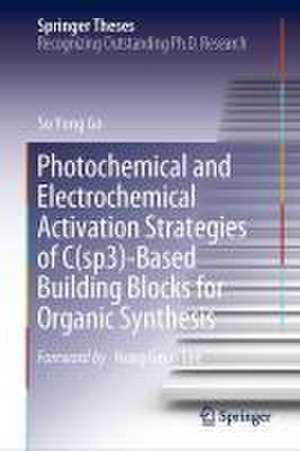Photochemical and Electrochemical Activation Strategies of C(sp3)-Based Building Blocks for Organic Synthesis: Springer Theses
Autor Su Yong Go Cuvânt înainte de Hong Geun Leeen Limba Engleză Hardback – 29 mar 2024
The second strategy enables the development of C(sp3)-heteroatom bond-forming reactions through the electrochemical activation of C(sp3)-B bonds. The bonding of heteroatoms to carbon atoms has been an enduring subject of investigation for organic chemists. The function of most molecules is mainly determined by heteroatoms attached to the carbon atom, althoughthe backbone structure of organic compounds comprises carbon fragments.
Din seria Springer Theses
- 18%
 Preț: 997.88 lei
Preț: 997.88 lei -
 Preț: 389.88 lei
Preț: 389.88 lei - 15%
 Preț: 646.94 lei
Preț: 646.94 lei - 18%
 Preț: 943.43 lei
Preț: 943.43 lei -
 Preț: 399.29 lei
Preț: 399.29 lei - 18%
 Preț: 944.99 lei
Preț: 944.99 lei - 15%
 Preț: 636.80 lei
Preț: 636.80 lei - 18%
 Preț: 941.05 lei
Preț: 941.05 lei - 15%
 Preț: 643.16 lei
Preț: 643.16 lei - 15%
 Preț: 642.68 lei
Preț: 642.68 lei - 18%
 Preț: 1103.62 lei
Preț: 1103.62 lei - 20%
 Preț: 558.82 lei
Preț: 558.82 lei - 18%
 Preț: 1112.30 lei
Preț: 1112.30 lei - 18%
 Preț: 944.19 lei
Preț: 944.19 lei - 18%
 Preț: 1109.92 lei
Preț: 1109.92 lei - 18%
 Preț: 1217.27 lei
Preț: 1217.27 lei - 15%
 Preț: 640.06 lei
Preț: 640.06 lei - 15%
 Preț: 636.45 lei
Preț: 636.45 lei - 15%
 Preț: 640.06 lei
Preț: 640.06 lei - 15%
 Preț: 640.88 lei
Preț: 640.88 lei -
 Preț: 389.70 lei
Preț: 389.70 lei - 20%
 Preț: 563.89 lei
Preț: 563.89 lei -
 Preț: 393.35 lei
Preț: 393.35 lei - 15%
 Preț: 637.93 lei
Preț: 637.93 lei - 15%
 Preț: 641.85 lei
Preț: 641.85 lei - 18%
 Preț: 1225.94 lei
Preț: 1225.94 lei - 20%
 Preț: 551.36 lei
Preț: 551.36 lei - 18%
 Preț: 1229.10 lei
Preț: 1229.10 lei - 15%
 Preț: 639.25 lei
Preț: 639.25 lei - 18%
 Preț: 999.45 lei
Preț: 999.45 lei - 15%
 Preț: 640.06 lei
Preț: 640.06 lei - 18%
 Preț: 1220.45 lei
Preț: 1220.45 lei - 18%
 Preț: 1116.26 lei
Preț: 1116.26 lei - 18%
 Preț: 1110.72 lei
Preț: 1110.72 lei - 18%
 Preț: 1000.87 lei
Preț: 1000.87 lei - 18%
 Preț: 891.17 lei
Preț: 891.17 lei - 15%
 Preț: 640.06 lei
Preț: 640.06 lei - 5%
 Preț: 1154.07 lei
Preț: 1154.07 lei - 15%
 Preț: 635.96 lei
Preț: 635.96 lei - 15%
 Preț: 640.88 lei
Preț: 640.88 lei -
 Preț: 387.20 lei
Preț: 387.20 lei - 18%
 Preț: 1109.92 lei
Preț: 1109.92 lei -
 Preț: 385.25 lei
Preț: 385.25 lei -
 Preț: 385.25 lei
Preț: 385.25 lei - 18%
 Preț: 1112.30 lei
Preț: 1112.30 lei - 18%
 Preț: 999.45 lei
Preț: 999.45 lei -
 Preț: 386.99 lei
Preț: 386.99 lei - 15%
 Preț: 637.13 lei
Preț: 637.13 lei - 20%
 Preț: 554.20 lei
Preț: 554.20 lei - 20%
 Preț: 555.57 lei
Preț: 555.57 lei
Preț: 891.48 lei
Preț vechi: 1087.17 lei
-18% Nou
Puncte Express: 1337
Preț estimativ în valută:
170.59€ • 178.55$ • 141.98£
170.59€ • 178.55$ • 141.98£
Carte tipărită la comandă
Livrare economică 31 martie-14 aprilie
Preluare comenzi: 021 569.72.76
Specificații
ISBN-13: 9789819989935
ISBN-10: 9819989930
Ilustrații: XXVII, 169 p. 257 illus., 166 illus. in color.
Dimensiuni: 155 x 235 mm
Greutate: 0.46 kg
Ediția:2024
Editura: Springer Nature Singapore
Colecția Springer
Seria Springer Theses
Locul publicării:Singapore, Singapore
ISBN-10: 9819989930
Ilustrații: XXVII, 169 p. 257 illus., 166 illus. in color.
Dimensiuni: 155 x 235 mm
Greutate: 0.46 kg
Ediția:2024
Editura: Springer Nature Singapore
Colecția Springer
Seria Springer Theses
Locul publicării:Singapore, Singapore
Cuprins
Part I. C(sp2)-C(sp3) Bond Formation Reactions Enabled by Photoredox/Nickel Dual Catalysis.- Chapter 1. The Key Concepts and Strategy in Photoredox/Nickel Dual Catalysis and Application to C-C Bond Formation Reactions.- Chapter 2. Highl Regioselective and E/Z Selective Hydroalkylation of Alkyne via Photoredox Mediated Ni/Ir Dual Catalysis.- Part II. Development of C(sp3)-Heteroatom Bond-Forming Reactions via Electrochemical Activation of C(sp3)-B Bonds and Follow-up Projects.- Chapter 3. Recent Achievements of C(sp3)-Heteroatom Bond Formation in Electroorganic Synthesis and History of C(sp3)-B Bond Activation.- Chapter 4. Introduction of Heteroatoms to Alkyl Carbocations Generated from Alkylboron Reagents via Electrochemical Activation.- Chapter 5. Functionalization of Alkylboron Compounds Under Other Reaction Conditions.
Notă biografică
Dr. Su Yong Go received his Ph.D. in 2023 under the supervision of Professor Hong Geun Lee at Seoul National University (SNU) for his organic chemistry research on the photochemical and electrochemical activation of alkyl compounds. He has been a postdoctoral fellow at the Research Institute of Basic Science (RIBS) at SNU since 2023 and is working in the field of synthetic organic electrochemistry.
Textul de pe ultima copertă
This book addresses novel C(sp3)-C(sp2) and C(sp3)-heteroatom bond-forming reactions. Two strategies are given in the book using photoredox or electrochemical methods. The first strategy describes that the hydroalkylation of alkynes via photoredox-mediated Ni/Ir dual catalysis produces trisubstituted alkenes as versatile synthetic building blocks for the synthesis of pharmaceutical agents and natural products. High regioselectivity and E/Z-selectivity were achieved by introducing silyl groups that can provide steric and electronic effects to these selectivities with extensive opportunities for post-functionalization.
The second strategy enables the development of C(sp3)-heteroatom bond-forming reactions through the electrochemical activation of C(sp3)-B bonds. The bonding of heteroatoms to carbon atoms has been an enduring subject of investigation for organic chemists. The function of most molecules is mainly determined by heteroatoms attached to the carbon atom, although the backbone structure of organic compounds comprises carbon fragments.
Caracteristici
Highlights new chemical phenomena using light or electricity Introduces in detail the photochemical and electrochemical activation of C(sp3)-based precursors Shares detailed information on various mechanism experiments and wide substrate scopes for organic synthesis
